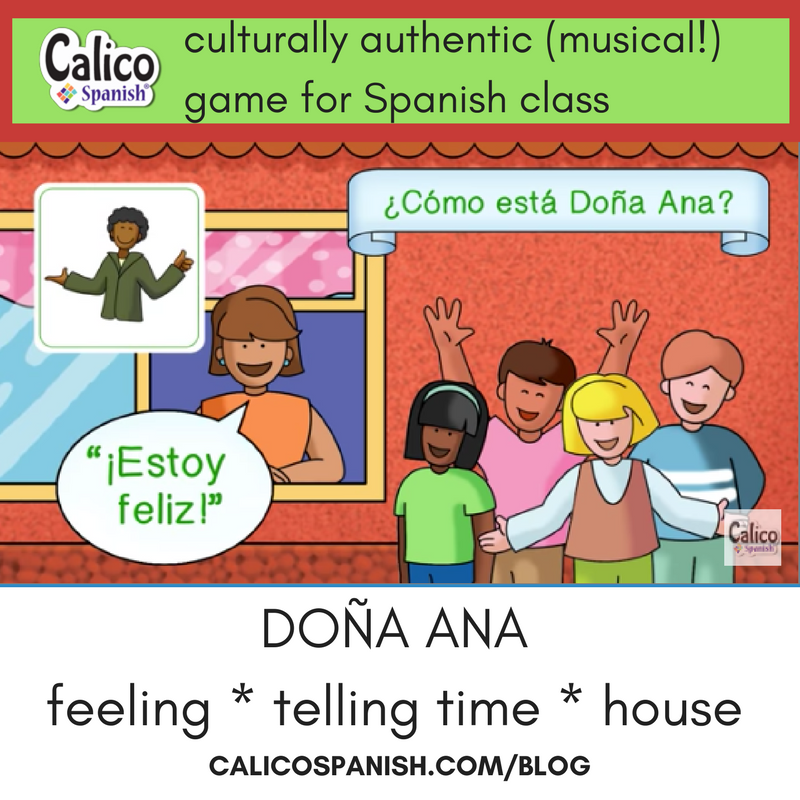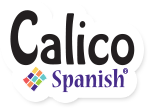Doña Ana: culturally authentic (musical!) game for Spanish class
We recently told you about Pañuelito, a culturally authentic game for reviewing vocabulary in Spanish class. Here we share Doña Ana. We incorporated this game into Calico Spanish Stories Level C (“I Live Here”), together with the song that inspired it.
– Follow us on Twitter –

– Like Calico Spanish on Facebook –
The many names of “Doña Ana”
The children’s song “Doña Ana no está aquí” is a ronda, a “round,” a song sung by children in a circle while playing a game. This ronda is sometimes attributed to Nicaragua. In Guatemala, you might hear it as “Vamos a la vuelta” and the star is a rana instead of Doña Ana. (We’re amused, because the family in Level C is a familia de ranas.) El Salvador claims it as either “Doña Ana” or “Doña Diana.” Whatever you call it, it’s been a common, fun ronda across Latin America for a very long time.
– Follow us on Instagram too! –
Original game
This is how the original game is played:
- Two children sit in the middle of the circle. One is Doña Ana, and the other is her caregiver.
- The children, holding each other by the hands and circling the two girls, sing about how Doña Ana is not here; rather, she is in her orchard tending her flowers.
- At the end of each short verse, the circling children ask, “¿Dónde está Doña Ana?”
- The caregiver can give any answer about where she is or what she is doing.
- The children continue to sing and then ask, “¿Cómo está Doña Ana?” until the caregiver responds, “¡Doña Ana se murió!” (Doña Ana is dead!).
- At this point, the circle comes in to approach the girls, and Doña Ana jumps up to chase the children in the circle.
- The child she catches is the next one to play Doña Ana.
Introduce a child you love to a lifelong journey of speaking real Spanish to real people. Click the red button to experience it FREE.
See it in action
If you’re like us, you need this visualized. Here are some children in Nicaragua playing the game.
As often happens with traditional children’s songs and games, there are many variations of “Doña Ana.” Often there is no caregiver; Doña Ana is the only child in the middle and answers for herself. Often the question
¿Dónde está Doña Ana?
is not asked, but rather only
¿Cómo está Doña Ana?
and Doña Ana answers that she doesn’t feel well, or that she has a fever, until she answers that she is dying, and then runs to catch the next Doña Ana.
Our update/game: House vocabulary + activities + telling time
In the version we present here, we have altered the lyrics to tell you that Doña Ana is in different rooms in her house, at a different time (on the hour), participating in a different activity in each place. She wants to know who these people are that keep coming in her house and keep her from doing what she wants to do. The children answer who they are: they are the children who are coming to eat in the red house, and by the way, how is Doña Ana?
To play the game with your children, use the video labeled “Doña Ana – para jugar.” In this version, when the children ask, “¿Cómo está Doña Ana?” there is no answer, so that your own Doña Ana can answer for herself.
The game should proceed this way:
- Assign gestures to different possible answers to ¿Cómo está? (See suggested gestures below.)
- When the song asks ¿Cómo está Doña Ana? the children in the circle should stop moving.
- You or someone in the circle should make one of these gestures at your Doña Ana. If she can respond correctly, she gets to run and catch a new Doña Ana. If she cannot, she plays Doña Ana for another round.
Example:
- Judith is in the middle playing Doña Ana.
- You, Andrew, and Bri circle around her (singing more and more of the song as you become more familiar with it) until…
- you ask, “¿Cómo está Doña Ana?” while rubbing your.
- Judith correctly answers, “Tengo hambre.”
- Then, she runs and catches Andrew, who will be the next Doña Ana.
Version 1: Including answers
Version 2: Without answers, for the game
Suggested answers and gestures:
You can probably see how you can use different questions here to tweak the game for practicing any vocabulary (“¿Qué tiene Doña Ana?“) but for the question of cómo estás, we suggest using these gestures to elicit the corresponding answers from your Doña Ana:
- Estoy bien : thumbs up
- Estoy mal : thumbs down
- Estoy triste : sad face, pretending to cry
- Estoy feliz : big smile
- Tengo hambre : rubbing stomach
- Tengo sed : panting
- Estoy listo / lista : posture to start running
- Tengo sueño : yawning
Ready to play? Here’s a PDF of the instructions included in Level C of Stories, if you’d like to print them out.. Also, you can get a poster of these answers to help children learn them well. That poster is included in our Level C poster pack. And snap a picture or video and share with us – we’d love to see how Doña Ana helps your learners improve their Spanish!






No Comments